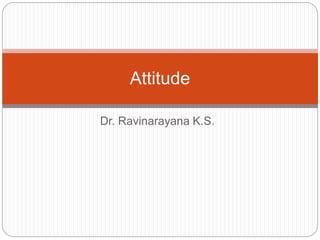Attitude.pptx
- 2. Introduction Attitude constitute an important psychological attribute of individuals which shape their behaviour. Attitude influences the behavior of the individuals. Attitude is a usual way of doing things. Successes and failures in life depend upon the attitude of the individuals. If attitudes are positive, then human relations will be positive. And positive human relations are necessary for a successful life.
- 3. Definitions Attitude is defined as the way a person feels about something- a person, a place, a commodity, a situation or an idea. Attitude expresses an individual’s positive or negative feelings about some object.
- 4. In simple words, an “attitude” is an individual’s way of looking or an individual’s point of view at something.
- 5. Attitudes refer to feelings and beliefs of individuals or groups of individuals. Attitudes tend to result in behaviour or action. All people, irrespective of their status or intelligence, hold attitudes.
- 6. For example, Some people think internet’s use for students as a positive thing that it help students in their studies. But an another way some people think the use of internet for students as a negative thing they think it wastes lot of time in useless
- 7. Types of Attitudes Attitude is something that lies between emotions and thought processing. Attitude may be positive or negative. If someone has good feelings about something e.g. towards his/her work, or people, then it is positive attitude otherwise it would be negative.
- 8. Positive attitude The predisposition that results in desirable outcomes for individuals and organizations can be described as positive attitude. Positive attitudes are rewarded. It means the individual is encouraged to do the same thing in future.
- 9. Negative attitude The tendency of a person that results in an undesirable outcome for individuals and organizations can be described as negative attitude. Negative attitudes are punished in order to discourage the same action in future.
- 10. Components of attitude 3 components of attitude are; Cognitive Component. Affective Component. Behavioral Component.
- 11. Cognitive Component The cognitive component of attitudes refers to the beliefs, thoughts, and attributes that we would associate with an object. It is the opinion or belief segment of an attitude. It refers to that part of attitude which is related in general knowledge of a person. Typically these come to light in generalities or stereotypes, such as ‘all babies are cute’, ‘smoking is harmful to health’ etc.
- 12. Affective Component Affective component is the emotional or feeling segment of an attitude. It is related to the statement which affects another person. It deals with feelings or emotions that are brought to the surface about something, such as fear or hate. Using the above example, someone might have the attitude that they love all babies because they are cute or that they hate smoking because it is harmful to health.
- 13. Behavioral Component Behavior component of an attitude consists of a person’s tendencies to behave in a particular way toward an object. It refers to that part of attitude which reflects the intention of a person in the short-run or long run. Using the above example, the behavioral attitude may be- ‘I cannot wait to kiss the baby’, or ‘we better keep those smokers out of the library, etc.
- 14. Examples to understand three components of attitude Anything we know about an object is cognitive component Based on our knowledge about an object, we have emotions of liking or disliking towards the object- these emotions are Affective component Based on our knowledge & emotions about the object, we act toward the object in a specific way- it is the behavioral component
- 15. Example 1 Orange is rich in Vitamins. It is good for the skin. It tastes good (cognitive component) I like oranges (Affective component) I eat an orange daily (Behavioral component)
- 16. Example 2 Led bulbs consume less electricity. It has brighter light. It is more durable (cognitive component) I like led bulbs (affective component) I buy and use led bulbs in my home (behavioral component)
















